
Confucius, born Kong Qiu was a Chinese philosopher of the Spring and Autumn period who is traditionally considered the paragon of Chinese sages. Confucius's teachings and philosophy underpin East Asian culture and society, and remain influential across China and East Asia to this day. His philosophical teachings, called Confucianism, emphasized personal and governmental morality, correctness of social relationships, justice, kindness, and sincerity, as well as an emphasis on a ruler's duty to their subjects.

Korean Confucianism is the form of Confucianism that emerged and developed in Korea. One of the most substantial influences in Korean intellectual history was the introduction of Confucian thought as part of the cultural influence from China.

Neo-Confucianism is a moral, ethical, and metaphysical Chinese philosophy influenced by Confucianism, which originated with Han Yu (768–824) and Li Ao (772–841) in the Tang dynasty, and became prominent during the Song and Ming dynasties under the formulations of Zhu Xi (1130–1200). After the Mongol conquest of China in the thirteenth century, Chinese scholars and officials restored and preserved neo-Confucianism as a way to safeguard the cultural heritage of China.

Yi Hwang was a Korean philosopher, writer, and Confucian scholar of the Joseon Dynasty. He is considered the most important philosopher of Korea - he is honored by printing his portrait on the 1000 Won banknote, on the reverse of which one can see an image of his school, Dosan Seaowon. He was of the Neo-Confucian literati, established the Yeongnam School and set up the Dosan Seowon, a private Confucian academy.

Korean court music comprises three main musical genres: aak, an imported form of Chinese ritual music; a pure Korean form called hyangak; and a combination of Chinese and Korean styles called dangak.
AakKorean pronunciation:[a.ak] is a genre of Korean court music. It is an imported form of the Chinese court music yayue, and means "elegant music". Aak was performed almost exclusively in state sacrificial rites, and in the present day it is performed in certain Confucian ceremonies.
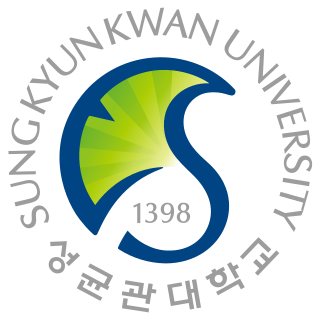
Sungkyunkwan University is a private research university with campuses in Seoul and Suwon, South Korea.
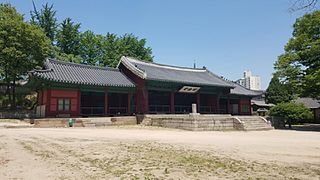
Sungkyunkwan (Korean: 성균관) was the foremost educational institution in Korea during the late Goryeo and Joseon Dynasties. Today, it sits in its original location, at the south end of the Humanities and Social Sciences Campus of Sungkyunkwan University in Seoul, South Korea. Twice a year, in May and September, the ceremonial rite Seokjeon Daeje is performed in the Munmyo Shrine, to honor Confucius and the Confucian sages of China and Korea.
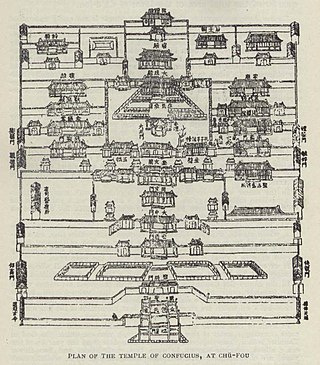
A temple of Confucius or Confucian temple is a temple for the veneration of Confucius and the sages and philosophers of Confucianism in Chinese folk religion and other East Asian religions. They were formerly the site of the administration of the imperial examination in China, Korea, Japan and Vietnam and often housed schools and other studying facilities.

Jo, also often called by his art name Jeong-am (정암), was a Korean Neo-Confucian scholar who pursued radical reforms during the reign of Jungjong of Joseon in the early 16th century.

Jongmyo (Korean: 종묘) is a Confucian shrine in the Jongno District of Seoul, South Korea. It was originally built during the Joseon period (1392–1897) for memorial services for deceased kings and queens. According to UNESCO, the shrine is the oldest royal Confucian shrine preserved and the ritual ceremonies continue a tradition established in the 14th century. Such shrines existed during the Three Kingdoms of Korea period (57–668), but these have not survived. The Jongmyo Shrine was added to the UNESCO World Heritage list in 1995.

Traditional Korean musical instruments comprise a wide range of string, wind, and percussion instruments. Many traditional Korean musical instruments derive from Chinese musical instruments.

The National Gugak Center, located in Seoul, South Korea, is the primary institution of learning for Korean traditional music, including both court music and folk music. It was founded in 1951 through a merger of Korean musical organizations.

The Supreme Council for the Confucian Religion in Indonesia is a Confucian church established in 1955 in Indonesia, comprising the communities of practitioners of Confucianism mostly among Chinese Indonesians. Together with the Hong Kong Confucian Academy it is one of the two branches that formed after the dissolution of mainland China's Confucian Church founded by Kang Youwei in the early 20th century.
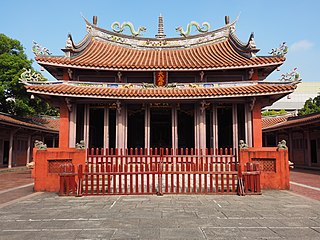
The Tainan Confucian Temple or Quan Tai Shou Xue, is a Confucian temple on Nanmen Road (南門路) in West Central District, Tainan, Taiwan.

Jongmyo jerye (Korean: 종묘제례) or jongmyo daeje (종묘대제) is a traditional rite held for worshipping the deceased Joseon monarchs in Jongmyo Shrine, Seoul, South Korea. It is held every year on the first Sunday of May. The jongmyo rite is usually accompanied with the court music playing (Jerye-ak) and dance called Ilmu or line dance. Jongmyo jerye and jeryeak were designated as the first of South Korea's Masterpieces of the Oral and Intangible Heritage of Humanity by UNESCO in 2001.
Gwon Geun was a Korean Neo-Confucian scholar at the dawn of the Joseon dynasty, and a student of Yi Saek. He was one of the first Neo-Confucian scholars of the Joseon dynasty, and had a lasting influence on the rise of Neo-Confucianism in Korea.
Yi Byeok was a scholar of Korea’s later Joseon period who, in 1784, played a leading role in the foundation of Korea’s first Catholic community. It is reported in one source that his original name was Yi Taek-jo.
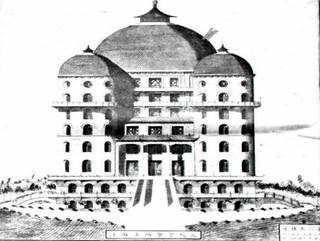
The Confucian church is a Confucian religious and social institution of the congregational type. It was first proposed by Kang Youwei (1858–1927) near the end of the 19th century, as a state religion of Qing China following a European model.

The Seokjeon Daeje (Korean: 석전대제), also sometimes called Seokjeonje, is a ceremonial rite performed twice annually to honor Confucius. It is held at Confucian sites across South Korea including hyanggyos and the Confucian temple Munmyo located at Sungkyunkwan, on Confucius' birthday in fall and the anniversary of his death in spring. Seokjeon is made up of the two Chinese characters, 釋 and 奠 (alcohol), and Seokjeon Daeje means "Laying out offerings ceremony". It involves an elaborate ceremony with sacrificial offerings of alcohol and foods, as well as an elaborate dance known as munmyo ilmu accompanied by musical performances munmyo jeryeak.



















